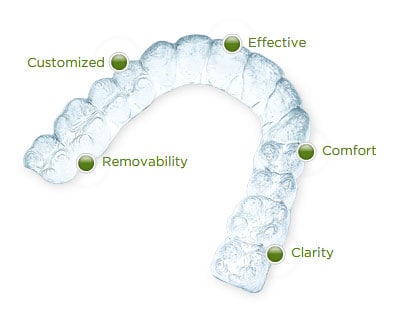Invisalign offers the same benefits available from metal braces but is different in several ways. In terms of similarity, this clear form of braces straightens teeth to give patients more confidence and makes patients less likely to suffer from cavities, gingivitis and other oral health maladies later. Also like metal braces, this option from our Gaffney orthodontics works by moving teeth into their positions slowly in stages over a variable amount of time. The ways in which clear braces differ from traditional braces involve comfort, oral health during treatment and virtual invisibility during treatment. Here is more about the unique advantages of clear braces.
Basic Construction
Metal braces and invisible braces both are designed individually based on consultations with patients. X-rays, bite impressions and photos are used in each case to refine the treatment plan. However, invisalign braces are made from durable plastic and can be removed. By contrast, metal braces are made of metal and use rubber bands to hold wires in place. The metal brackets used with traditional braces are bonded to the teeth, which means they can only be removed at our orthodontic office after treatment is complete.
Discretion
Clear braces are difficult for other people to notice, making them preferable for patients who do not want to attract extra attention to a smile that has not yet completed correction. While traditional braces have metal brackets and wires that affect appearance dramatically, clear braces let teeth shine through so that patients feel comfortable in social situations. This discretion is further improved because the clear plastic aligners do not collect food particles, which are easily caught on the brackets of metal braces.
Easier Eating
Because traditional braces are bonded to the teeth, they require careful consumption or avoidance of certain cold or hard foods, such as ice cream and pork rinds, to avoid breakage. Invisible braces let patients eat the foods they want because the aligners are removable. With either type of braces, patients should rinse or brush after eating to avoid stains and oral health problems from any food particles that remain.
Comfort
As mentioned in our Braces FAQ, traditional braces are known for the discomfort they cause in the days after the brackets are first attached and after the wires are tightened. Invisible braces can also cause temporary discomfort at the beginning of treatment and when patients switch aligners. Unlike metal braces, however, clear braces lack the brackets and wires that often cause abrasion in the mouths of patients with traditional braces. People all over the world are talking about this; Questions can be answered on Reddit.
https://nthdegreeorthodontics.com/invisalign-reddit-amazing-links/
Oral Health Support
Invisible braces are better for oral health than metal braces for two reasons. First, they do not trap food particles and plaque around brackets and wires because they simply have none. Second, invisible braces can be removed for brushing and flossing and can even be cleaned directly outside of the mouth. With metal braces, patients may have to use special brushing techniques and spend extra time threading floss through the wires to clean between teeth effectively. Buildup of food and plaque contribute to cavities and gingivitis, and both of these issues are less likely to occur with clear braces because they sidestep the problem.
Faster Treatment Time
As noted in our Braces FAQ, orthodontic treatments vary in length depending on how much treatment individuals need. However, clear braces commonly finish straightening teeth more quickly than traditional braces do. Whereas metal braces may take up to two years or more to straighten teeth, invisible braces may finish correcting teeth in anywhere from six months to two years. Average length of treatment with invisible braces is 18 months. Restorations required beforehand and any additional appliances, such as palate expanders, may also prolong the total treatment period.
Three Clear Options
Metal braces can be customized across a wide range of treatment needs, but three types of invisible braces are available at our orthodontic office to suit different patients. Clear braces are available in Full, Invisalign Teen and Express versions.
Invisalign Full corrects teeth in adults and older adolescents with average orthodontic requirements.
Invisalign Teen is designed for younger adolescents and includes a number of extra features, including spare aligners in case of damage or loss and indicators that let our orthodontist check for compliance. The Teen aligners also are designed to accommodate continuing growth in this group.
Express uses a smaller number of aligners compared to the Full version and is intended for patients who have only minor bite irregularities. Patients may choose this option for orthodontic relapse or to prepare for upcoming events where they want to look their best.
The results of clear braces depend on compliance with treatment as well as the abilities of the orthodontist who designs the aligners and treatment plan. Our orthodontists are experienced correcting many different bite irregularities with clear braces, making our office a reliable solution for patients seeking healthier, better-looking teeth with many advantages over traditional braces. Treatment with clear braces begins with a consultation to assess the teeth and determine the best ways to correct issues that are found. Contact Nease and Higginbotham Orthodontics today to arrange a consultation and find out if Invisalign is the right type of braces for you.
Contact Us Today for an Appointment
Not every orthodontic office has two experts to examine and treat patients but Nease and Higginbotham Orthodontics does. We make it convenient to drive to our facilities by having three locations in South Carolina:
• Spartanburg Orthodontics
• Gaffney Orthodontics
• Duncan Orthodontics
At our state-of-the-art orthodontic facility, patients have the opportunity to meet with two qualified orthodontists who understand how to determine the most appropriate braces for patients. Anyone with unsightly misaligned teeth can schedule an appointment with a telephone call or online form to talk to:
• Dr. Phil Higginbotham
• Dr. Eric Nease



